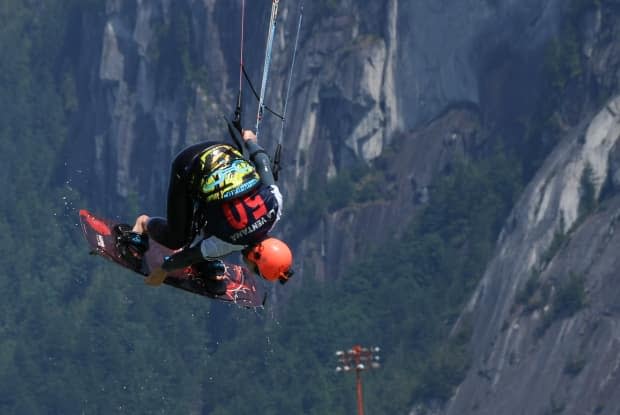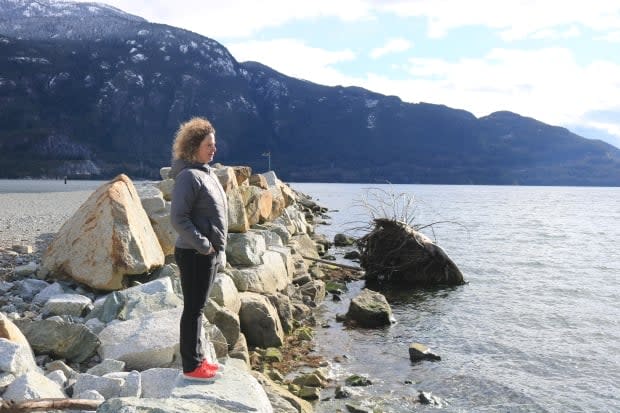Kiteboarders and salmon advocates at odds over latest plans to deconstruct Squamish Spit road

Even on a cold February afternoon — months before the kiteboarding season starts up — the Squamish Spit is a recreational hot spot.
Dog-walkers, hikers and cyclists make their way to the end of the dike that juts out into the head of Howe Sound. The wind chills aren't enough to prevent them from taking in views of the Squamish Chief towering over the water.
"The mountains and the ocean all together at once, they're just beautiful views," said Michelle Fennings, who was out for a bike ride down the spit on Friday. "This is probably one of our favourite spots to come."
When temperatures are warmer, the spit becomes one of Canada's premier wind-sports hubs.
Nikki Layton first came across it more than six years ago, and she's been a kiteboarder ever since.
"I've kited in Maui, I've kited in Mexico," she said. "But this place is just so magnificent, you're out there kiting, the seals are playing, and you have these amazing rock structures beside you. It's just mind-boggling."

But the days of easy access to the spit could be coming to an end — and soon.
For years, plans have been in motion to restore salmon populations that have been disrupted by the dike.
According to the Squamish River Watershed Society (SRWS), all signs point to decommissioning about a kilometre of road in September that leads to the end of the spit, making an island of the remaining patch of land. Those plans have yet to be finalized.
Layton, who is president of the Squamish Windsports Society, says the group was blindsided by the latest developments, which have deviated from earlier plans to improve salmon habitat while maintaining road access to the spit.
The society is now scrambling to figure out how it will be able to maintain user access to the site once the the road is deconstructed.
"That's the five-to-ten-million-dollar question," said Layton.
Salmon decline
The spit partially divides the Squamish estuary from the Squamish River. The watershed society says the spit's impact on chinook salmon stocks was almost immediately noticed when it was built in the 1970s. It was initially constructed to provide access to a coal port that was never built.
Reports suggest salmon populations in the river were as high as 15,000 per year prior to construction. Populations declined to as few as 500 in the mid-1980s, but have since risen to 5,000 due to restoration.

In 2017, the watershed society partnered with the DFO and the Squamish Nation to figure out how to improve connectivity between the estuary and the river.
"Juvenile chinook require a certain amount of time in the estuary before they go out in the ocean for survival," said Edith Tobe, executive director of the Squamish River Watershed Society. "The river is acting like a fire hose, shooting them out into Howe Sound."
"Basically, this has been cutting them off all those years," said Tobe.
Spit deconstruction
The SRWS has secured $1.6 million for the rehabilitation project. In a December 2017 funding agreement between the DFO and SRWS, it's suggested that the spit would be realigned to create "300 hectares of wetted tidal habit for salmonids" and "maintain road access for wind-sport and recreational enthusiasts."

Tobe says the original proposal was "pie in the sky" and, according to early modelling, wouldn't have achieved restoration goals.
Now the plan is to deconstruct a kilometre of road, without replacement, starting in September. The plans are subject to approval by the District of Squamish and regulators.
Tobe says the watershed society is willing to share its data with recreational groups so users can come up with their own solution to the access problem.
The wind-sports society is campaigning for an alternative access road that would run from downtown Squamish to the end of the spit. But for now, it's unclear where the money would come from.

"At no point are we saying we don't want them to do what they need to do," said Layton. "We're just saying give us a enough time so we can work together to build a realignment, rather than a pure removal."

